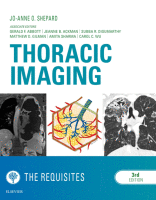Physical Address
304 North Cardinal St.
Dorchester Center, MA 02124

Introduction The mediastinum is bounded anteriorly by the sternum, posteriorly by the thoracic spine, laterally by the mediastinal pleura, superiorly by the thoracic inlet, and inferiorly by the diaphragm. It contains vital intrathoracic structures and organs, including the heart, aorta,…

Introduction Positron emission tomography (PET) has become an important imaging tool in thoracic oncology over the past 10 to 20 years. It has proven its usefulness in the diagnosis of malignancies, initial staging, assessing response to treatment, and posttreatment monitoring…

Introduction Uses of Thoracic Magnetic Resonance Imaging Chest radiography (CXR) and chest tomography (CT) have been the mainstays of thoracic imaging for decades, and 18-fluorodeoxyglucose positron emission tomography (FDG-PET)–CT has more recently proven its value in staging lung cancer and…

Normal Anatomy Trachea and Main Bronchi The trachea is a midline cartilaginous and fibromuscular tubular structure that extends from the inferior aspect of the cricoid cartilage to the carina. The intrathoracic length of the trachea normally ranges from 6 to…

Introduction This chapter reviews various x-ray–based techniques used in thoracic imaging, including radiography, fluoroscopy, digital tomosynthesis, and computed tomography (CT). Conventional, Computed, and Digital Radiography Merely 1 year after discovery of x-rays by Wilhelm Konrad Roentgen, calcium tungstate was chosen…